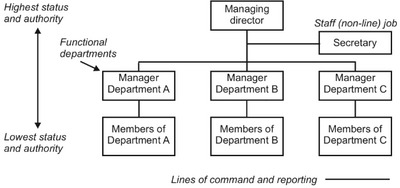Project organization
Purpose --> Understanding the context
Abstract
The success of a project is highly dependent on the term project organization. The term is defined as a clear establishment of the project management team structure along with a communication approach in the beginning of the project. Maintaining the project organization during the entire project is essential to make the project a success. According to the PRINCE2 standard, the purpose of project organization is to define and establish the project's structure of accountability and responsibilities [1].
To successfully create and institutionalize a project organization, the project authority should be clearly communicated throughout the project team. This implies that each project team member knows their respective responsibilities. An effective way to visualize and hence intuitively communicate the organizational structure along with its division of authority is using organization charts (or organigrams). [2].
Contents |
Big idea
- What is project organization (including essential aspects described), and what is its purpose (why is it important)?
- What consequences occur if project organization is neglected?
Project organization is a term describing the structure of a project throughout its entire lifecycle based on communication, coordination and management. The purpose of project organization is to define a structure of responsibilities and accountability across the project management team [1]. Therefore, an effective establishment of a project organization requires unambiguously communicated authority. Additionally, each project management team member should know their specific role along with the associated responsibilities. Neglecting efficient organization of projects often leads to a lack of motivation, which causes schedule overruns and hence budget overruns [2]. Accordingly, well planned project organization it is essential to the success of the project. However, it is important to acknowledge that effective project organization only reduces the need for change throughout the project lifecycle and does not completely eliminate the need for change. Therefore, despite organizing the project effectively, project managers still need to be open-minded towards changes throughout the project lifecycle [3].
State of the art
- What are the current modern and updated ways of doing this? (This have will be further discussed in applications).
- Agile versus non-agile
Application
- How should project managers approach project organization?
This section will provide a broad type of guidance to PMs, which is applicable to all projects.
- What do they need to reflect upon before diving into different methods and tools?
This section will describe what needs to be considered in the individual projects before choosing which methods to apply. This is because every project is unique despite there is a lot of identical aspects in all projects.
Existing tools and methods to organize projects
- What different methods/tools exist, and what characterizes each of them?
...
An effective way to establish the project management team structure and the communication foundation is through organizational charts.
Organization charts (organigrams)
Organizational charts vertically represent the role or status and authority of each organization member. The status and authority decreases from top to bottom of the chart, which means the most powerful member organizational role is located in the top of the chart. This tool is very powerful to demonstrate and clearly communicate the authority and roles within projects. Additionally, it emphasizes the internal organizational context of the project. This can further be useful to communicate the organizational project governance structure and interdependencies between the specific project and other projects and/or programs of the organization.

Project matrix organizations
Project team organization
Agile PM methods with well-established project organization
- How are agile methods like SCRUM or KANBAN applied to a well organized project?
Section 8.12 [3]
- Are agile methods more applicable than rigid methods like the waterfall method?
Tool/method 3
Limitations
- Critical reflection regarding project organization in general.
- What can each tool/method do, and under what circumstances should they be applied?
- Which tools/methods are a part of the current standards of project organization, and which ones extend the current standards of project organization.
Organizational charts
Despite organization charts are very effective to communicate organizational structure and division of authority, they are illustrated by vertical lines of communication. In practice, communication is far more complex due to informal communication across the organization. Hence this tool is mostly applicable to organizational structure and its responsibility division rather than constraining the organizational communication [2].
Agile PM methods with well-established project organization
Discussing Tool/method 3
Annotated bibliography
References
- ↑ 1.0 1.1 A. (2017). Managing successful projects with prince2 2017 edition. The Stationery Office Ltd., Available at: https://ebookcentral.proquest.com/lib/dtudk/reader.action?docID=4863041 (Accessed: 12 February 2023).
- ↑ 2.0 2.1 2.2 2.3 2.4 D. Lock, Project Management. 10th edn., (Gower Published Limited, 2013), pp. 131–154, Available at: https://www.perlego.com/book/1645789/project-management-pdf (Accessed: 12 February 2023).
- ↑ 3.0 3.1 Kerzner, Harold. (2017). Project Management: A systems approach to planning, scheduling, and controlling - Section 11.8 and 8.12. 12th ed. Wiley.
- ↑ Project Management Institute, Inc. (PMI). (2021). A Guide to the Project Management Body of Knowledge (PMBOK ® Guide) – 7th Edition and The Standard for Project Management - Section 2.2.1 and 3.2. Project Management Institute, Inc. (PMI). Sections respectively retrieved from https://app.knovel.com/hotlink/pdf/id:kt012LZGJB/guide-project-management/project-team-management and https://app.knovel.com/hotlink/pdf/id:kt012LZF39/guide-project-management/create-collaborative (Accessed: 12 February 2023)